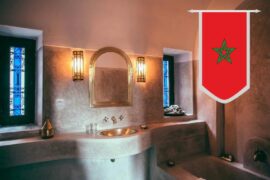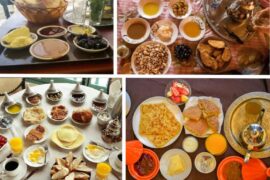The Medina of Fez City (1981)
Fez city is located in northern Morocco and was the first registered UNESCO World Heritage Site in Morocco. It was founded in the 9th century and was the capital of the Marinid dynasty in the 13th and 14th centuries. Most of the major monuments in the medina, date to the Marinid dynasty period and there is the oldest University in the world called Al Qaraouiyyin.
The Medina of Marrakech City (1985)
Marrakech, also called Red City, is located in western Morocco. It was founded in the 1070s and for a long time, it was an important center politically, economically, and culturally. It hosts many monuments from that period such as the kasbah, the Koutoubia mosque, the battlements, gardens, the cultural space of Jemaa el-Fna Square,…etc.
Nowadays, this is the number one tourist city in Morocco receiving big numbers of worldwide visitors.
Kasbah/Ksar of Ait-Ben-Haddou (1987)
The Kasbah of Ait-Ben-Haddou is an impressive historic landmark located in southern Morocco 34km Northwest of Ouarzazate. It’s an example of the traditional Southern Moroccan architecture surrounded by high walls reinforced by towers in corners.
This fortified village is a popular film location for many Hollywood movies and must be on your list while you are in Marrakech or Ouarzazate.
Only three and half hours from Marrakech and there are many day trips organized to this stunning ancient village.
City of Meknes (1996)
Meknes is an imperial Moroccan city founded by the Almoravids in the 11th century and is located in northern central Morocco. It is the former capital of the Alaouite dynasty that still rules Morocco and the city is influenced by the Spanish-Moorish style of the 17th and 18th centuries which is still present today.
Volubilis’s Archaeological Site (1997)
Volubilis, the important outpost of the Roman Empire, was founded in the 3rd century BCE and then becomes the capital of the Idrisid dynasty founded by Idris I. It is still possible to see some of its buildings remain on the archaeological site.
Medina of Tetouan (1997)
During the 8th century, the Medina of Tetouan was the contact point between Morocco and Andalusia. After the reconquest, the Andalusian refugees rebuilt the town and their influence is evident in the city’s art and architecture.
Medina of Essaouira (2001)
Essaouira, formerly called Mogador by the Portuguese, is located on Morocco’s Atlantic coast. This fortified town was built in the late 18th century mixing the North African and European architecture principles.
The Portuguese City of Mazagan (2004)
The Portuguese Fortified City of Mazagan, which today is a part of El Jadida city, is an example of the influence interchange between European and Moroccan cultures. From the Portuguese period, the surviving buildings are the Manueline Church and the cistern.
Rabat, The Capital of Morocco (2012)
Rabat is a modern Capital and historic city located northwest of the kingdom on the Atlantic coast. The oldest part includes the Hassan mosque, Almohad ramparts, and gates as well as the settlements’ remnants from the 12th to the 17th century of Roman, Phoenicians, Moorish, and Andalusian.
Tbourida Tradition in Morocco (2021)
World Heritage in Morocco on the Map
Any new registered Unesco World Heritage Sites in Morocco will be added to the article in the future.



